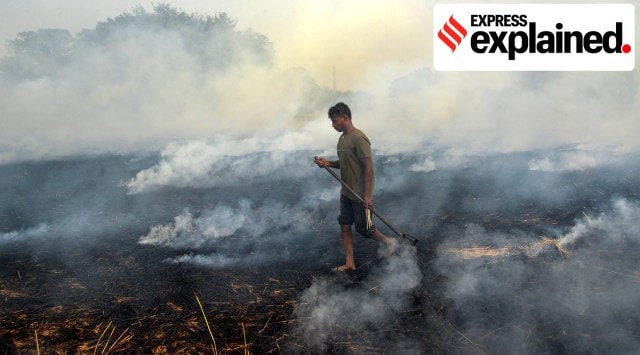What is partial stubble burning and why do many farmers resort to this?
After harvesting, farmers opting for partial burning let the loose straw dry for a couple of days and then they set these dumps on fire to prepare the field for the next crop.
 The short and long-duration paddy varieties have a height of 4 feet and over 5, respectively. (PTI)
The short and long-duration paddy varieties have a height of 4 feet and over 5, respectively. (PTI)Many farmers this year said that they are not burning the paddy stubble completely and are instead resorting to partial burning or burning only the loose straw. What does this mean and how does this lessen the air and soil pollution level, the Indian Express explains:
What do they mean by loose straw and standing stubble?
The short and long-duration paddy varieties have a height of 4 feet and over 5, respectively. The combined harvesters that farmers use to harvest paddy, cut off the upper portion of the paddy and leaves behind a standing stubble of around 15 to 18 inches, which is called standing stubble. It throws the chopped 2.5 feet loose stubble on the field after taking the grain portion from the shaved part of the stubble. This loose straw gets accumulated in several small dumps in the field which is called the loose straw.
What is partial stubble burning?
After harvesting, farmers opting for partial burning let the loose straw dry for a couple of days and then they set these dumps on fire to prepare the field for the next crop. In such cases, the standing stubble, which is mostly green, does not get burnt fully but it gets scorched close to those places in the field where loose straw is burnt.
Why do farmers opt for partial stubble burning?
The state has distributed 1.05 lakh stubble management machines and a large number of individual farmers and groups of farmers have purchased these machines on subsidy. Farmers who do not have these machines but want to manage the stubble, get these on rent from farmers groups and cooperative societies. However, even after having three main machines such as Happy Seeder, Smart Seeder and Super seeder, many farmers are resorting to partial burning, officials said. The three machines ensure that there is no need for partial burning even after harvesting as stubble clearing is not required to sow wheat.
Experts said that farmers see stubble as the enemy of soil and the next crop but it is not. A farmer, who rented a super seeder for sowing wheat, told The Indian Express that he did not want to burn the loose straw because he wanted to show it through the Super Seeder but the owner of the machine asked him to burn the loose straw first as it will help super straw to run smoothly in the field “so I did the same,” he added.
A senior officer said that farmers only want to see their field clean at the time of sowing of new crops and with these three machines except Super Seeder, stubble remains in the field even after sowing. “To avoid this sight post wheat sowing, farmers resort to partial burning without paying attention towards the soil and air health,” the officer said, adding that instead of giving a clean look to the field, they should keep the environment clean and should not do even partial burning.
Does partial burning help in lessening air and soil pollution?
Experts said that if farmers are burning just 10-12 spots where the loose straw gets accumulated in the field and fire is not inching toward the remaining field then it will save the remaining part of the field from burning. “But it is rare. And in the case of air pollution, it will be around 40-50% less as they only burn around 50% to 60% of the total stubble in such cases,” experts said.
- 01
- 02
- 03
- 04
- 05






































